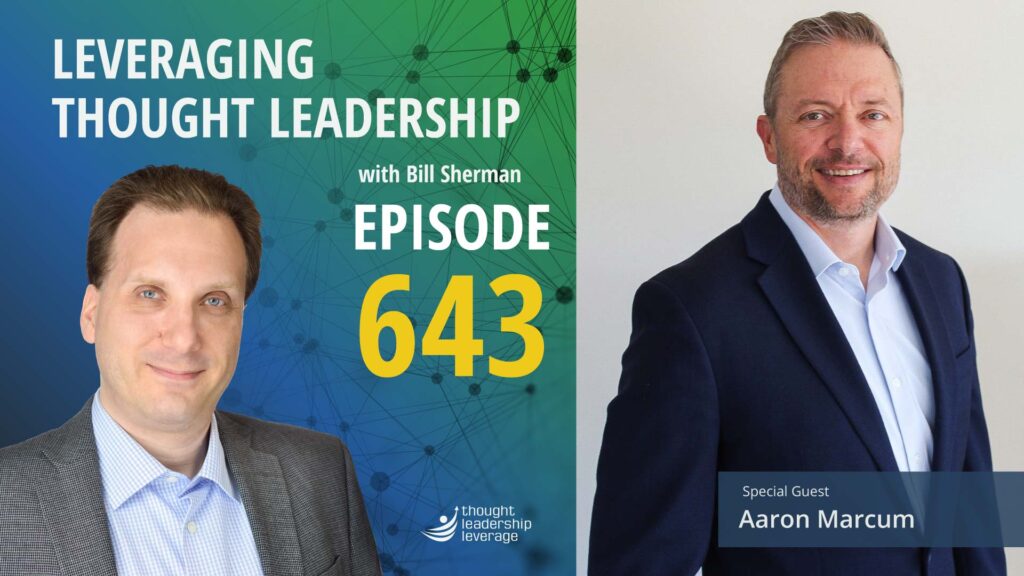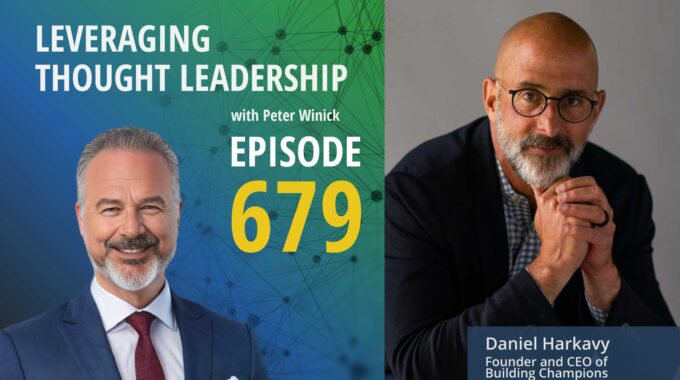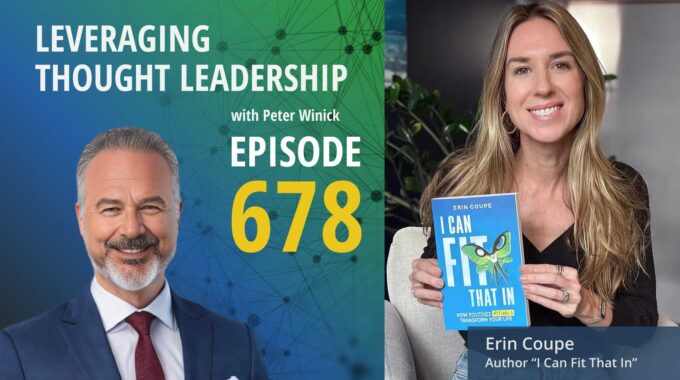A roadmap for leaders who want to multiply their impact — not their workload. This…
Leading with Data, Scaling with Purpose | Aaron Marcum

How purpose, psychology, and storytelling fuel lasting thought leadership
This episode explores how thought leadership can evolve from an accidental byproduct into a deliberate strategic asset. It examines the role of data storytelling in scaling influence, driving brand visibility, and increasing enterprise value. The conversation also highlights how positive psychology and purpose-driven frameworks can help entrepreneurs overcome burnout and create lasting impact beyond their business.
What if your greatest business challenge could become your launchpad into thought leadership?
Today, Bill Sherman sits down with Aaron Marcum, visionary behind Breakaway 365 and bestselling author of EntreThrive, to explore how a journey from entrepreneur to industry thought leader unfolds—often unintentionally. Aaron shares how his frustration with data gaps in the home care space led to the founding of a data analytics company and, unexpectedly, a national reputation as a thought leader. Along the way, he leveraged the insights of thinkers like Brian Tracy and Michael Gerber, and later deepened his impact through a Master’s in Applied Positive Psychology under the guidance of Dr. Martin Seligman.
Aaron breaks down how storytelling with data shifted his role from CEO to an in-demand industry voice, fueling brand growth, product evolution, and ultimately, a lucrative exit. But he didn’t stop there. With EntreThrive, he’s now equipping entrepreneurs to beat burnout, overcome inertia, and find lasting fulfillment. Whether he’s on stage, coaching leaders, or writing his next big idea, Aaron exemplifies how thought leadership evolves with intention and legacy in mind.
He doesn’t just teach frameworks—he lives them. And his mission? To empower other coaches and entrepreneurs to do the same, with impact that extends beyond business and into family, travel, and values.
Three Key Takeaways
Thought Leadership Can Be Accidental—But It Shouldn’t Stay That Way: Aaron began as a consumer of thought leadership, applying insights from Brian Tracy and Michael Gerber to his business. Over time, he evolved into a recognized voice in the home care industry by solving real problems with data, eventually becoming an intentional and strategic thought leader.
Data + Storytelling = Impact: His ability to interpret data and turn it into actionable insights transformed his brand visibility, customer engagement, and exit valuation. By controlling the narrative through thought leadership, he elevated his company’s reputation and market value.
Purpose Drives the Next Chapter: After exiting two companies, Aaron continues to lead with purpose—not for profit, but for impact. Through EntreThrive and Breakaway 365, he’s focused on coaching entrepreneurs to overcome burnout and thrive, combining positive psychology, personal experience, and a calling to serve others.
If you’re exploring how thought leadership can evolve from personal insight to organizational strategy, this episode offers complementary perspectives. In Discovering Thought Leadership, Mark Smith shares his journey from HR research to establishing a formal thought leadership role at SHRM, navigating internal structures to align research with actionable business goals.
Transcript
Bill Sherman How do you evolve from being a consumer of good thought leadership to a practitioner who shapes an entire industry? Aaron Markham’s journey spans founding and scaling companies, creating data-driven insights, and writing the best-selling book, Entre Thrive. Today, he leads Breakaway 365, helping entrepreneurs navigate burnout, build purpose, and accelerate growth. In this episode, We explore how Aaron turned personal experience, data, and passion into a lasting platform of impact through thought leadership. I’m Bill Sherman and you’re listening to Leveraging Thought Leadership. Ready? Let’s begin. Welcome to the show, Aaron.
Aaron Markum So good to be here, Bill, appreciate you having me.
Bill Sherman I’m excited for this conversation because you’ve practiced thought leadership in a number of different forms, wearing different hats. You’ve been a CEO and an executive founder who’s used thought leadership. You’ve left that company and exited and continued your journey on thought leadership, and now you’ve even written your own book. So I want to explore this thought leadership journey with you. Let’s go back to when you first started using thought leadership in your business, how did that happen? And where did this idea come from?
Aaron Markum Yeah. You know, initially with my first business, this is, well, this was way back in 2002. I, I was an avid, I mean, I, love to learn and so forth. And I, found the work of Brian Tracy back then, you know, who I consider a thought leader, you know, he wrote the psychopathy achievement. And I started just absorbing all of his work. And I remember listening to the cassette tapes and I, I just, uh, not only just- listening to it, but I would write down, how does this apply to my home care business? What can I use? And I use some of the psychology, the sales psychology that he had. And he talked a lot about, but that was my first introduction. I think back when I first started my own, my homecare company into thought leadership before that consumer of it, you know, ironically full circle, he wrote the introduction to my book. Uh, so 20 plus years later, and so it was a wonderful, just, uh, just crazy situation where I was introduced to him towards the end of my, I was almost done writing my book and I was, uh we had a mutual friend and that was just full circle was amazing to, to pick his brain right before I published my book, and I have him part of that whole process, but thought leadership for me started then. And then I became a fan of Michael Gerber, E-Myth. I went through his E-myth mastery. So I was a consumer initially of thought leadership. And halfway through my journey with my home care company, I saw some, I was frustrated with a few things. I saw a need for data and analytics and quality standards in the home care space. I didn’t know at the time how that would catapult me into a thought leadership role. I really, that was not my intent. That’s not where I was going with it. I wanted to change an industry. I wanted it to create better quality standards. So I founded a company after my, after my exit with my home care company that would answer the frustrations I experienced in my homecare business. Like so many companies are born right from our own frustrations. And as I launched that and we started gathering all this data and we started making a difference in the industry, then I was kind of put out into this. I wasn’t expecting it. In fact, I remember my, my first time I spoke in public when I had that company, when I was asked to speak upon on our data, I was like, I did not do a very good job by the way. I was really a fish out of water. And I, I, um, I learned a lot from that experience. But then over time, you know, became quite a thought leader in the home care industry. I spoke at the same conference for like 10 years straight. I mean, it was constantly being asked to speak and really share a lot of the things that I was learning through the process of, again, starting with the data. But then, over time it turned into leadership and it turned to how do we grow better cultures? And it turned into these things that I- It just kind of evolved over time. It wasn’t even later on. It became more intentional, but initially it was not intentional. Now I’m extremely intentional about how, about my thought leadership, but yeah.
Bill Sherman And I want to stay with the data analytics company. Yeah. So you form a data analytics and company, and you’re saying there are issues such as employee turnover that can be addressed if we had better data client turnover for the home care company. If we had. Better data. And so you had been a consumer of thought leadership. But you didn’t sort of like say, Oh, I can create thought leadership in this space from your story. I’m hearing you were an accidental ball leader rather than a purposeful leader. I really
Aaron Markum Was, and what happened was, if you think about it, when it comes to data, data, like having the data is one thing, but knowing what to do with it is another. And when I married the two, like, for example, we measured employee turnover. We would give them their results. And this is specific to their business, not just we’d give them industry results and specific results to their business. And then they would say, well, how do I, how do I change that? How do I improve that? And then I started absorbing thought, you know, from other thought leaders. Again, okay, here’s the problem. They had this high turnover. What are some ways that we can help solve that for them? And I started marrying these things together and therefore becoming like sharing things about later on Martin Seligman, of course, and others. But Michael Gerber and Jim Collins. And I started absorbing a lot of these other thought leaders and their answers to the problem. And then over time, I started building my own, like realizing, okay, we’ve got other ways we can solve this. And I was bringing, kind of bolting all these different ideas and concepts and bringing them together into strategies. And then we started even selling the strategies to our customers. That we were pulling together. So let’s stay there for a moment.
Bill Sherman At some point, the storytelling around the data became conscious thought leadership. How did that impact the business and how did it impact your role as a CEO?
Aaron Markum I would say that was the, you think about the flywheel, you know, that Jim Collins and others talk about is that was what really pushed it forward. Is that when we became, and I, me specifically more than, more than anything, cause I was running that company, I was a CEO and I was a former home care business owner. I think some of the best thought leaders, they have been in the shoes of the people they’re trying. To teach and coach and share this information is because I had been in their shoes, I understand what their frustrations were, I could therefore speak on topics that would resonate with them. And it was that in sharing the information and how to solve some of their biggest challenges that put our company into the forefront of the industry. I mean, thought leadership for me back then. Was the catapult. It was the mechanism that pushed us into the limelight.
Bill Sherman And in terms of pushing to the limelight, are you talking about brand recognition? Are you talking about customer acquisition? Are you talking about, you know, the account penetration, all of that? What was the it?
Aaron Markum Yeah, it was brand recognition. Our brand was getting out there far more, more intentional too. I mean, initially, I think with a lot of companies, your brand can get out there in ways that maybe you don’t want it to get out, there are people will misunderstand it and the thought leadership, we started controlling the conversation and the narrative and really what our brand was all about. If that makes sense. So we were really able to, to talk specifics about the data and what we’re measuring and tie that to our products and services and how we can help solve some of their biggest challenges. And so it really put our brand far more on the forefront. Eventually, I mean, when I exited, that brand is the reason I was able to exit for what I did. And it started with that thought leadership and getting out into the into the. You know, with conferences, speaking, a lot of webinars, we had had like 2000 home care companies register for one webinar, you know, and we were just, because we were sharing best practices and what was working and what wasn’t working, and I’d had these, the highest attending webinars by far in our industry because of that thought leadership.
Bill Sherman So before we leave your data analytics company, I want to ask you two questions, maybe put you a little bit on the spot as well. So the first question is, if you were practicing thought leadership on behalf of the company, how much of your time as CEO was spent doing thought leadership?
Aaron Markum That depends on the year, right? Early on, early on, I was, I remember in 2017, I was, my thought leadership was 80% of my time was in thought leadership. Rewind to 2015, 2014, 2015, I was, it was probably still about 60, 40. But the problem was, is I was working weekends. I was work in evening things. Well, that’s the entrepreneur, right?
Bill Sherman Right?
Aaron Markum Crazy out.
Bill Sherman Which is why I asked you percentage rather than hours, right?
Aaron Markum Yeah, so 2017, I was in what I call my guiding genius. I was really doing the things that I love to do, which was thought leadership. Like that was, that’s what gives me energy still does today is when I can share these things with others and really help elevate others personally and professionally.
Bill Sherman So 2017 before exit, 70% of your time was focused on thought leadership. Yes. And then the second question on the followup of that is you connected your exit valuation to thought leadership? I don’t know if you can put a specific number as a percentage, but I would love to hear how much did thought leadership impact the EXIT VALUATION.
Aaron Markum I think I don’t even know if that, if there would have been an exit without it, so you can just think of the impact there and it was, it was a nice exit. And the reason is, is because they were buying, we’re a service company, right? We’re, we, you know, they’re obviously buying our customer base. We had, we had at the time, um, 2,500, 3000 to 3000 customers, home care providers using our services. And it was our voice, our brand, our impact that we had made through. Again, I really believe it was because we were considered the thought leaders in the industry. When I, in 2018, I actually stepped down as CEO and continued to coach and do some other things. And I would call myself the visionary in the company, chairman visionary. And one of the reasons was is because I knew I wanted to exit around, you know, a couple of years later and so I wanted the company to, to kind of move into that role, into that thought leadership role and replace me as the thought leader. Because up until that point, you couldn’t really separate Aaron Markham from the company in that sense. I was the thought, leader for the most part. And so we did it in a very intentional transition, about a two year transition. Replacing me as a thought leader and really moving the company into that role. And it worked really well, but that transition wasn’t even possible if I hadn’t started, you know, putting us on the map, I guess you could say. And so putting a number on it’s hard, I would say I don’t think the exit would have even happened without it.
Bill Sherman That’s fantastic on its own.
Bill Sherman If you’re enjoying this episode of Leveraging Thought Leadership, please make sure to subscribe. If you’d like to help spread the word about our podcast, please leave a five-star review at ratethispodcast.com/ltl, and share it with your friends. We’re available on Apple podcasts and on all major listening apps, as well as thoughtleadershipleverage.com/podcast.
Bill Sherman So let’s move forward. You’ve exited from that company. You’ve now done your second exit. And like everyone that I know who does an exit, you decide to go back to school. And what was it that you stumbled upon and how did you wind up going back into an education program after your second accent? Tell me that story.
Aaron Markum Yeah, you know, it started actually before the exit. I found positive psychology back in 2017. I read the book The Happiness Advantage by Sean Acor was my first introduction to positive psychology. I was introduced to Martin Seligman, not physically introduced, that came later, but I was introduce to his work and the book Flourish. And I just started absorbing this partly because I wanted to apply it into our own business. And so when I stepped down as CEO in 2018, I was still focused on culture there. I was focused on building the best culture I could build, a meaningful culture. And we had it just because of the principles I was learning, I was just constantly applying them into the business. And so, when I exited in 2020, I became so fascinated with the field of positive psychology that I applied to the top program in the world at UPan, the master of applied positive psychology, because I, I wanted to learn more and I just, I absorbed all the books. I’d read pretty much everything I could read. I’m like, I, guess the next step is I got to get my master’s degree. I don’t know. That was kind of my, the way I was thinking at the time. And I’m so grateful. It was absolutely transformational. It’s a hard program to get into. I was surprised that I got into. They obviously didn’t go off my grades in my undergrad, um, but off the 20 years of experience, you know, and I was able to get in there and Martin Seligman was my professor, which was amazing. He was my, that first semester. In fact, that very first day I was, had, was able to have a conversation with, with Martin, uh, Dr. Seligmen and, uh. And he’s the father of positive psychology. He’s the, you know, the founder. And what fascinated me about positive psychology was that it wasn’t about, it’s not the science of happiness. And in fact, Dr. Seligman, Marty was very adamant in that first day that we understood that fact. He was, he’s the guy behind learned helplessness. I mean, he had a long time and he’s like, this is the positive psychology is the proactive side of psychology.
Bill Sherman Rather than what’s wrong with you.
Aaron Markum Yeah, exactly. Rather than what’s wrong, let’s say what’s right with you. And how can we get in front of some of these challenges and these issues? How can we create, like in the workplace, a more self-determined worker or employee? And what’s the science behind all of that? And so there’s been so much research done in the field of positive psychology by people like Martin Seligman, Chris Peterson. Mihaly Csikszentmihalyi, so many that, uh, that I’ve done so much research in that field, which, and it continues to be Marty is, he’s kind of the, many of his, his colleagues have passed like Chris Peterson and Mihaly Csikzentmihaj and Marty still, still moving along. And he still teaches at UPenn. He’s 80, I want to say Marty’s 83, 84, somewhere in there. Pretty amazing. But from that, I was able to work with some amazing people, but I went into the program, I think with any program like this, especially at this point in my career, is I learn best when I have my target audience in mind and how I want to apply the principles. So right from the get-go, I had the entrepreneur in my mind, myself, and how could solve some of their greatest issues. Burnout, stress, anxiety. Especially some of those aspiring entrepreneurs. My whole capstone was about the aspiring entrepreneur and why they quit so quickly. We often hear it’s cash, but in my research, that’s secondary. They don’t necessarily run out of cash, they run out steam. They run out freedom. So anyway, it’s fascinating to talk about why they quite so quickly And some of the best ideas don’t get to it, you know, don’t come to fruition because of that, because of the issue. And I wrote a whole capstone on that.
Bill Sherman And I want to turn to your work now as a practicing thought leader, right? You’ve written a book, you’ve identified a target population, you said entrepreneurs, and you’ve really been trying to create. Yeah. My question is, first question is why, why continue to practice thought leadership? What is it in you that fuels you?
Aaron Markum I think I’m, not think, I know I’m wired for it. I talk about this in my book, this grit scale. Angela Duckworth talks about it in her book a little bit, but it’s, you know, it starts with curiosity, interest, you know, curiosity is the first one. Interest is the second. Practice is the third, passion’s the fourth and calling’s the fifth. And the further you get on that grit scale or that grit continuum, the more staying power you have. And as a thought leader, I feel called to that. I feel, called to share, to not only share what I’ve learned, like a lot of people share what they learn, but I have this ability, this innate ability to take various learnings and create application for a specific audience. In this case, entrepreneurs. Right now, I work with a lot of home health, home care, healthcare type entrepreneurs, senior living as well. And I love working with them. But I also, I’ve helped. Companies like trucking companies as well. It’s so much of this information and the thought leadership that I share with entrepreneurs is agnostic. My book, Entre Thrive, is for the general entrepreneur. Um, these eight laws that I talk about in the book. And, and I just feel called to it, Bill. I just, you know, it’s not the money anymore. It’s really feeling called and I don’t, I don’t want to ever retire. It’s just not in my DNA. It’s the retire I’m not against people who do, but it’s not in my DNA.
Bill Sherman So when I asked that question of others who are founders who have exited, executives who have left an organization that they have led for many years, I’ve heard them express things like I don’t want to ride off into the sunset on a golf. Is it that you also want to stay relevant or help me understand?
Aaron Markum That’s really a good question. I made a promise to myself before I even exited my last company that regardless of what the exit looked like, or even if I could justify retirement, I made promise to my self that I would continue to make an impact, continue to learn and never grow complacent. And I think those promises that we make to ourselves are the most important promises that make. Add I’ve really tried to stay true to that promise is that I, if I can continue to give and be continue to be a giver and not a taker and, and, you know, I, I love to, you now, one of my favorite things is to go out and learn and learn from other thought leaders and being able to share that. I, a lot of people aren’t that, aren’t wired like that necessarily. And so I And that’s great. I mean, that’s my audience is, uh, most of them are not thought leaders. And so if I can be that person to go and make those connections, I mean my coach is Dan Sullivan with strategic coach. I mean he’s very well known out there and I’m one of the very few have Dan as their coach and I make that kind of investment because I know other people probably aren’t willing to make that if I could make that investment and take some of the things that Dan is sharing with me. And help these other entrepreneurs that I’m working with, understand things better and how to apply some of these principles in their own lives. Because I don’t have the market on, neither does Dan, neither does anyone, have the mark it on everything thought leader. You know, I mean, there’s so much out there and so if I can just start pulling and grabbing and applying it into their lives, that’s just what I feel like I’m called to do, wired to do.
Bill Sherman So let me ask you a question looking forward. You’ve described many different phases on your journey as a thought leader. Consumer, CEO, student, practitioner, okay, as a retired exec and founder. I want you to look forward maybe three, five years. Where does your thought leadership journey take you? Where are you heading and why?
Aaron Markum One of the, one of the things that I, three to five years from now that I would really like to see with our breakaway program break, so our coaching programs called breakaway 365 is reach the point where we’re coaching the coaches, right? We’re, we’re the thought leader for the other thought leaders in a sense. You know, I guess you could say, um, or people at least who are trying to make an impact and coaching on our framework, we have a You know, I pull, I pulled together this five elements of our framework. It’s called the breakaway framework and it’s a cycling term. I’m into biking where you break away from the competition and we help people do that is three to five years from now. I want to be able to be coaching the coaches to where, where it’s a wider impact so that they’re making a bigger impact on the people that they are working with. And so that’s, that’s where I see this program and see where we’re going. Um, the second part, three to five years from now is more personally related, more personally driven is one of the things I’m extremely proud of. And though my wife and I have done with our kids is that we’re about travel and experiences. And so I want to continue to elevate that. My kid’s confidence has come from a lot of times it’s come from the travel that they’ve been able to enjoy over the last several years, even from an early age, our kids have traveled. And so that’s. That’s part of the legacy, I guess you could say that I’m trying to build for myself, both personally and professionally as, uh, is with my own, my own family, my wife and my kids.
Bill Sherman And then one last question for you. Yeah. There are many people who listen to this podcast who are on their own journey, but often lessons learned can be applied across. What is one challenge that you faced as a thought leadership practitioner and how did you overcome it?
Aaron Markum Back when I, I mentioned 2014, 2015, when I was working so much, you know, and still trying to become that thought leader is that I, was not giving up control and I, wasn’t very good at delegating, I wasn’t very good building a team. And I think that the thought leaders, when you think about thought leaders who have rarely been able to lean into that and become those kinds of leaders, they have the right people, the right team in place so that they can do that, they can enjoy that. So that’s been one, I don’t know if this answers your question, Bill, but that’s one thing, one lesson I have learned as a thought leader is that I have to free myself up to be able to have the energy to do that. To learn and experience, right? The best thought leaders are the ones who’ve been on the front lines and have experienced it, learn how to overcome it. And apply it and can teach others, you know, the path. I don’t listen to thought leaders who haven’t traveled the path that I want to travel, right, that they haven’t, you know, they, they’re great consultants, but they’re not thought leaders in that sense.
Bill Sherman A great closing line. And I would love to continue the conversation, but we’re going to have to leave it there is to look to people who have traveled the path, maybe before you or in a different way. Thank you for joining us today, Aaron. Oh, it’s been fun.
Aaron Markum Thank you, Bill. Been really fun. Appreciate that.
Bill Sherman Okay. You’ve made it to the end of the episode, and that means you’re probably someone deeply interested in thought leadership. Want to learn even more? Here are three recommendations. First, check out the back catalog of our podcast episodes. There are a lot of great conversations with people at the top of their game, and thought leadership, as well as just starting out. Second, subscribe to our newsletter that talks about the business of thought leadership. And finally, feel free to reach out to me. My day job is helping people with big insights. Take them to scale through the practice of thought leadership. Maybe you’re looking for strategy, or maybe you want to polish up your ideas or even create new products and offerings. I’d love to chat with you. Thanks for listening.





